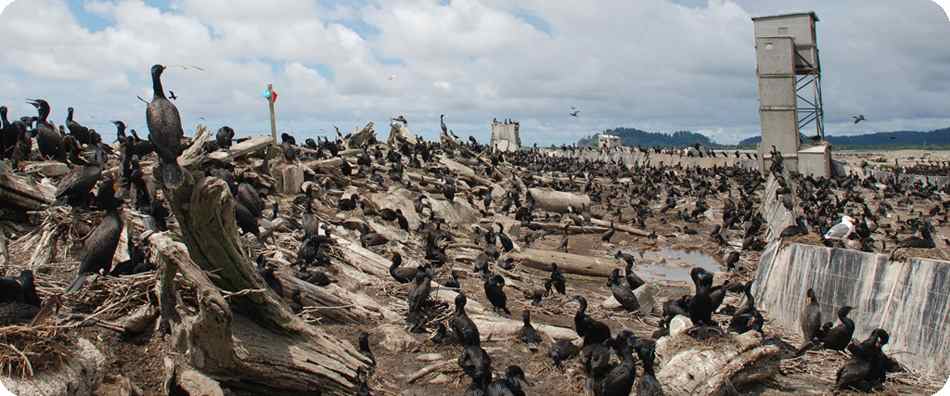forum
library
tutorial
contact

Killing Cormorants Not Improving
Steelhead Survival Rates
by Laura Berg
NW Fishletter, June 6, 2016
|
the film forum library tutorial contact |

|
Killing Cormorants Not Improving
by Laura Berg
|
 A recent study by a U.S. Fish and Wildlife Service scientist says double-crested cormorants are not a significant factor in the low survival rates of returning Snake River steelhead, contradicting NOAA Fisheries' position that the reduction in bird predation by lethal removal benefits salmon and steelhead survival.
A recent study by a U.S. Fish and Wildlife Service scientist says double-crested cormorants are not a significant factor in the low survival rates of returning Snake River steelhead, contradicting NOAA Fisheries' position that the reduction in bird predation by lethal removal benefits salmon and steelhead survival.
Steve Haeseker, a biologist and statistician with the FWS, told members of the Independent Scientific Advisory Board on May 20 that his study showed that "cormorant predation rates were not a significant factor for steelhead smolt-to-adult survival rates (SARs) after accounting for other freshwater and ocean factors."
The cormorants prey on juvenile salmon, steelhead lamprey and other fish, including Snake River steelhead, a species considered threatened under the Endangered Species Act,
This spring, for the second year, the FWS authorized the killing of 3,114 double-crested cormorants and the destruction of 5,247 cormorant nests. The birds are being culled from an island built from dredged material near the mouth of the Columbia River.
The Audubon Society of Portland and four other groups challenged the killing of cormorants, filing a lawsuit April 20, 2015, against the FWS, U.S. Army Corps of Engineers and U.S. Department of Agriculture Wildlife Services. The Corps developed the culling plan, while Wildlife Services is carrying out the plan.
The U.S. District Court of Oregon has yet to rule on the lawsuit.
Last spring Haeseker's study was leaked to the Audubon Society, which released it to the public in August 2015.
Although the results of Haeseker's analysis are still preliminary, he said that killing double-crested cormorants probably won't improve the survival of other fish species. The study will incorporate current data and be peer-reviewed before becoming final.
Haeseker also told the ISAB that a "similar analytic approach could be applied to Chinook SARs and pinniped (sea lion) abundance."
Recently, NOAA Fisheries told those attending a May 4, 2016, Columbia Basin Partnership workshop that both cormorants and terns were a problem and that their growing populations have increased predation-related mortality of salmon and steelhead.
The agency's data showed cormorant predation has increased to about 8 percent of the juvenile Columbia and Snake river steelhead since the 2000-2006 period and to nearly 6 percent of the juvenile Snake River spring/summer Chinook over the same period.
In 2015, the Corps said double-crested cormorants eat about 11 million juvenile salmon and steelhead each year.
Haeseker's analysis did not look at total predation rates alone. His study asked what the impact of cormorant predation had on Snake River steelhead survival by analyzing whether the predation was additive or compensatory.
Additive refers to different sources of mortality that are independent, while compensatory is increased mortality from one source and decreased mortality in other sources.
Haeseker used three sets of Snake River steelhead PIT-tag data from 1998 to 2009 to compare predation rates, as a percent of juveniles, with smolt-to-adult return rates.
The results, he said in his presentation to ISAB, "were consistent with the complete compensation hypothesis and strongly rejected the total additive hypothesis."
Quoting from a 2011 ISAB report on Columbia River Basin food webs, he noted that losses of juvenile steelhead might be "compensated by reduced losses during later life stages. Such compensation would be expected if predators selectively remove the most vulnerable individuals."
The variables in determining juvenile steelhead mortality and survival included seasonality, water transit time, spillway passages, spring-summer Pacific Decadal Oscillation (ocean conditions) and cormorant predation rates.
NOAA Fisheries addressed and set aside the issue of compensatory mortality when the agency prepared the 2014 Biological Opinion on the Federal Columbia River Power System.
In testimony presented to the federal court March 3, 2015, in defense of the 2014 BiOp, NOAA Fisheries' Ritchie Graves, chief of the Columbia Hydropower Branch, said that even assuming compensatory mortality (other predators eat some of the juvenile steelhead), the reduction in the size of cormorant population would still save some juveniles. "The issue," he wrote, "is largely moot."
A possible hint about how the federal court in Oregon may see the issue came in March, when a federal judge in Washington, D.C., ruled that the FWS cormorant reduction program that affects 24 states in the eastern United States failed to provide adequate scientific evidence that lethal removal of cormorants actually delivers benefits to the fish it is meant to protect.
learn more on topics covered in the film
see the video
read the script
learn the songs
discussion forum
